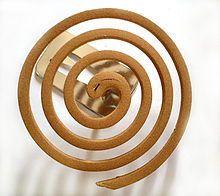- Mosquito coil
-
Mosquito coil is mosquito-repelling incense, usually shaped into a spiral, and typically made from a dried paste of pyrethrum powder. The coil is usually held at the center of the spiral, suspending it in the air, or wedged by two pieces of fireproof nettings to allow continuous smoldering. Burning usually begins at the outer end of the spiral and progresses slowly toward the centre of the spiral, producing a mosquito-repellent smoke.[1] A typical mosquito coil can measure around 15 cm in diameter and lasts up to 8 hours. Mosquito coils are widely used in Asia, Africa, and South America.[2]
Contents
Invention
Pyrethrum was used for centuries as an insecticide in Persia and Europe,[3] and the mosquito coil was developed around 1890s by a Japanese business man, Eiichiro Ueyama. At that time in Japan, people usually mixed pyrethrum powder with sawdust and burned it in a brazier or incense burner to repel mosquitoes. Initially, Ueyama created incense sticks mixed from starch powder, dried mandarin orange skin powder, and pyrethrum powder. However, the bar-shaped mosquito sticks quickly burned up in about 40 minutes, too brief for a long repelling action. In 1895, his wife, Yuki, proposed making the sticks thicker and longer, and curling them in spirals. In 1902, after a series of trials and errors, he finally obtained a desired incense burning effect out of a spirally-shaped mosquito repellent. The method involved cutting from a thick bar of incense to a certain length and manually winding it. This method continued to be used until 1957, where mass production was made possible through machine punching, making a far larger manufacturing scale possible.[4][5] After the Second World War, his company, Dainihon Jochugiku Co. Ltd, set up joint-venture firms in various countries, such as China and Thailand, to produce products suited to the actual local conditions.[5]
Ingredients
The active ingredients found in mosquito coils can be some of the following:[6]
- Pyrethrum (Natural, powdered material from a kind of chrysanthemum plant; performance moderated)
- Pyrethrins (Extract of insecticidal chemicals in pyrethrum)
- Allethrin (sometimes d-trans-allethrin) (The first synthetic pyrethroid)
- Esbiothrin (A form of allethrin)
- Dibutyl hydroxyl toluene (BHT) (An optional additive to prevent pyrethroid from oxidizing during burning)
- Piperonyl butoxide (PBO) (An optional additive to improve the effectiveness of pyrethroid)
- N-(2-ethylhexyl)-bicyclo-(2,2,1)hept-5-ene-2,3-dicarboximide (MGK 264) (An optional additive to improve effectiveness of a pyrethroid)
Advantages
Mosquito coils nowadays burn without flame for up to eight hours of continuous repelling action. In quantitative tests, they provide about 80% protection.[6] Mosquito coils are also cheap and need no special equipment to use it other than just lighting it up. They are portable and fit into normal household practices of lighting candles or incense.
Disadvantages
There are several hazards that are known to be caused by mosquito coils. In 1999, sparks from mosquito coils ignited a fire that swept through a three-story dormitory building at a summer camp in South Korea; 23 persons, including 19 children, died in the blaze.[7] Recent studies showed that the smoke generated from burning mosquito coil is of certain health concerns – one burning mosquito coil produces the same amount of particulate mass (diameter up to 2.5 μm) as 75-137 burning cigarettes would; and the emission of formaldehyde from one burning coil can be as high as that released from 51 burning cigarettes.[2]
See also
References
- ^ McKean, Erin, ed (2005). "Mosquito Coil". The New Oxford American Dictionary. Oxford University Press. pp. 1105.
- ^ a b Liu, Weili; Zhang, Junfeng; Hashim, Jamal H.; Jalaludin, Juliana; Hashim, Zailina; Goldstein, Bernard D. (September 2003). "Mosquito Coil Emissions and Health Implications". Environmental Health Perspectives 111 (12): 1454–1460. doi:10.1289/ehp.6286. PMC 1241646. PMID 12948883. http://www.ehponline.org/members/2003/6286/6286.pdf.
- ^ "Aromatica: History of pyrethrum". Bioaromatica Ltd. http://www.aromatica.hr/eng/page.asp?id=buhac&sub=buhac3. Retrieved 31 October 2009.
- ^ Debboun, Mustapha; Frances, Stephen P.; Strickman, Daniel (2007). Insect repellents: principles, methods, and uses. Boca Raton: CRC Press. pp. 6. ISBN 0-8493-7196-1.
- ^ a b International Business Organization of Osaka, Inc (2004). "Great People of Osaka: Eiichiro Ueyama - Developing and promoting insecticide together with pyrethrum". Osaka business Update 4. http://www.ibo.or.jp/en/2004_4/ud03.html. Retrieved 31 October 2009.
- ^ a b Strickman, Daniel; Frances, Stephen P.; Debboun, Mustapha (2009). Prevention of Bug Bites, Stings, and Disease. New York: Oxford University Press. pp. 117. ISBN 978-0-19-536577-1.
- ^ Trumbull, Charles P., ed (2000). "Disasters". Britannica Book of the year. 2000. Encyclopaedia Britannica, Inc. pp. 161.
External links
Categories:- Insect repellents
- Insecticides
- Incense
Wikimedia Foundation. 2010.

